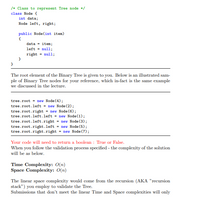
Computer Networking: A Top-Down Approach (7th Edition)
7th Edition
ISBN: 9780133594140
Author: James Kurose, Keith Ross
Publisher: PEARSON
expand_more
expand_more
format_list_bulleted
Question
thumb_up100%
Java
[1] Performing a check of constraints on node values for each sub-tree, just the way we discussed in the Lecture this week. Please remember what we dis[1]cussed in the Lecture - that - for a Binary Tree to qualify as a Binary Search Tree, we must perform the node values check of-course but also must not forget the value checks at the sub-tree level.
[2] Performing the BST check by doing an In-Order Traversal of the Binary Tree as discussed in the Lecture. Since we know that an in-order traversal of a BST results in nodes being processed in sorted order, as soon as there is a violation of sorted order, we would know that the tree provided is not a BST.

Transcribed Image Text:/* Class to represent Tree node */
class Node {
int data;
Node left, right;
public Node(int item)
data = item;
left = null;
right - null;
The root element of the Binary Tree is given to you. Below is an illustrated sam-
ple of Binary Tree nodes for your reference, which in-fact is the same example
we discussed in the lecture.
tree.root - new Node (4);
tree.root.left = new Node (2);
tree.root.right = new Node (6);
tree.root.left.left = nev Node(1);
tree.root.left.right = new Node (3);
tree.root.right.left = new Node (5);
tree.root.right.right = new Node (7);
Your code will need to return a boolean : True or False.
When you follow the validation process specified - the complexity of the solution
will be as below.
Time Complexity: 0(n)
Space Complexity: 0(n)
The linear space complexity would come from the recursion (AKA "recursion
stack") you employ to validate the Tree.
Submissions that don't meet the linear Time and Space complexities will only
Expert Solution
This question has been solved!
Explore an expertly crafted, step-by-step solution for a thorough understanding of key concepts.
This is a popular solution
Trending nowThis is a popular solution!
Step by stepSolved in 5 steps with 6 images

Knowledge Booster
Similar questions
- Design an algorithm and write code to find the first common ancestorof two nodes in a binary tree. Avoid storing additional nodes in a data structure. NOTE: This is not unecessarily a binary search tree.arrow_forwardQ#A hierarchical tree structure has a self-similar structure. What does this mean? Group of answer choices 1. Each branch of the tree must be balanced, so all sub-trees have the same number of internal and leaf nodes. 2. Two different hierarchies will have the same structures. 3. It means that any operations that add or delete elements, they must first create a duplicate structure, and remove or add elements from that similar structure. 4. Each sub-part of the hierarchy is also a hierarchy.arrow_forwardHello there, I have to write a Binary Search Tree program in Java that has to insert, delete, search, find max, find min, printing the elements in Binary Search Tree in pre-order, post-order, and in-order. But I am struggling to understand how I can print the pre-order, post-order, and in-order elements with its frequency. Can someone help me with the question I have, please? Question: Printing an element: An element from the BST will always be printed along with its frequency. For example, if there is a node in the BST that contains the element −7, and its frequency is presently recorded as 2, the data in the node will be printed as−7(2) Another example: 1 100 1 50 1 50 1 100 1 100 5 6 0 Output: 100(3)50(2)50(2)100(3) Hope someone can help me understand the coding, please :) Thank you.arrow_forward
arrow_back_ios
arrow_forward_ios
Recommended textbooks for you
 Computer Networking: A Top-Down Approach (7th Edi...Computer EngineeringISBN:9780133594140Author:James Kurose, Keith RossPublisher:PEARSON
Computer Networking: A Top-Down Approach (7th Edi...Computer EngineeringISBN:9780133594140Author:James Kurose, Keith RossPublisher:PEARSON Computer Organization and Design MIPS Edition, Fi...Computer EngineeringISBN:9780124077263Author:David A. Patterson, John L. HennessyPublisher:Elsevier Science
Computer Organization and Design MIPS Edition, Fi...Computer EngineeringISBN:9780124077263Author:David A. Patterson, John L. HennessyPublisher:Elsevier Science Network+ Guide to Networks (MindTap Course List)Computer EngineeringISBN:9781337569330Author:Jill West, Tamara Dean, Jean AndrewsPublisher:Cengage Learning
Network+ Guide to Networks (MindTap Course List)Computer EngineeringISBN:9781337569330Author:Jill West, Tamara Dean, Jean AndrewsPublisher:Cengage Learning Concepts of Database ManagementComputer EngineeringISBN:9781337093422Author:Joy L. Starks, Philip J. Pratt, Mary Z. LastPublisher:Cengage Learning
Concepts of Database ManagementComputer EngineeringISBN:9781337093422Author:Joy L. Starks, Philip J. Pratt, Mary Z. LastPublisher:Cengage Learning Prelude to ProgrammingComputer EngineeringISBN:9780133750423Author:VENIT, StewartPublisher:Pearson Education
Prelude to ProgrammingComputer EngineeringISBN:9780133750423Author:VENIT, StewartPublisher:Pearson Education Sc Business Data Communications and Networking, T...Computer EngineeringISBN:9781119368830Author:FITZGERALDPublisher:WILEY
Sc Business Data Communications and Networking, T...Computer EngineeringISBN:9781119368830Author:FITZGERALDPublisher:WILEY

Computer Networking: A Top-Down Approach (7th Edi...
Computer Engineering
ISBN:9780133594140
Author:James Kurose, Keith Ross
Publisher:PEARSON

Computer Organization and Design MIPS Edition, Fi...
Computer Engineering
ISBN:9780124077263
Author:David A. Patterson, John L. Hennessy
Publisher:Elsevier Science

Network+ Guide to Networks (MindTap Course List)
Computer Engineering
ISBN:9781337569330
Author:Jill West, Tamara Dean, Jean Andrews
Publisher:Cengage Learning

Concepts of Database Management
Computer Engineering
ISBN:9781337093422
Author:Joy L. Starks, Philip J. Pratt, Mary Z. Last
Publisher:Cengage Learning

Prelude to Programming
Computer Engineering
ISBN:9780133750423
Author:VENIT, Stewart
Publisher:Pearson Education

Sc Business Data Communications and Networking, T...
Computer Engineering
ISBN:9781119368830
Author:FITZGERALD
Publisher:WILEY